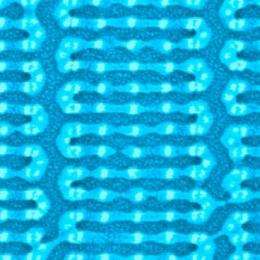March 16, 2010 report
Molecules could create tiny circuits on computer chips

(PhysOrg.com) -- As the features on computer chips become increasingly smaller, finding ways to fabricate the chips has become a big challenge. In a new study, researchers from MIT have demonstrated that certain molecules can be deposited on mostly empty chips, where they arrange themselves into patterns that form the outlines of tiny functioning circuits. Researchers Karl Berggren, the Emanuel E. Landsman Associate Professor of Electrical Engineering, and Caroline Ross, the Toyota Professor of Materials Science and Engineering, have published their new method in a recent issue of Nature Nanotechnology.
As explained in an article at MIT News, the process currently used to fabricate circuits on chips - photolithography - has changed very little over the past 50 years. Photolithography involves shining a light through a patterned mask onto a layer of light-sensitive material coated on the computer chip. Light exposure causes the photoresist to harden, and when the unhardened area is washed away, only the patterned area remains.
However, now that chip features have become smaller than the wavelength of light used in this process, photolithography cannot be used anymore. To confront this challenge, researchers have tried using electron beams instead of light beams due to their smaller wavelength. However, the problem with electron-beam lithography is that it takes a long time, and so it is more expensive. Unlike photolithography, which can expose an entire chip at once with light, an electron beam is more focused and can only expose small areas at a time, so that it has to scan back and forth across the chip to cover the entire area.
In the new method, Berggren and Ross have greatly minimized the need for electron-beam lithography, using it only to create sparsely patterned guidance posts throughout the chip. To fill in the patterns between the posts, they deposited long, repeating chains of polymer molecules that attach themselves to the posts and then arrange themselves in specific patterns. To get the desired patterns, the researchers used copolymers, which are made of two different types of polymer molecules. The different polymer chains don’t like to mix, yet they are still joined together - like “the characters played by Robert De Niro and Charles Grodin in the movie Midnight Run, a bounty hunter and a white-collar criminal who are handcuffed together but can’t stand each other,” in Berggren's analogy. By trying to pull away from each other, the polymers arrange themselves into predictable patterns.
Later, when exposed to a plasma, one of the polymers turns to hardened glass, while the other burns away. Like in photolithography, the glass polymer could be used as the photoresist, which hardens to form the pattern. By controlling different characteristics - such as polymer lengths, their relative proportions, and the shape and location of the posts - the researchers could produce a variety of specific patterns that could be useful for designing circuits.
With its minor reliance on electron-beam lithography, the new method could offer cost-effective fabrication in areas besides computer chips. For example, the technique could be used to produce stamps for creating magnetic patterns on hard disks, which are currently produced with electron-beam lithography. However, more research is required before manufacturing individual computer chips with self-assembling molecules, such as getting the molecules to form the exact patterns needed to produce functioning circuits.
More information:
Joel K. W. Yang, Yeon Sik Jung, Jae-Byum Chang, R. A. Mickiewicz, A. Alexander-Katz, C. A. Ross & Karl K. Berggren. “Complex self-assembled patterns using sparse commensurate templates with locally varying motifs.” Nature Nanotechnology. Doi:10.1038/nnano.2010.30.
via: MIT News
© 2010 PhysOrg.com



















